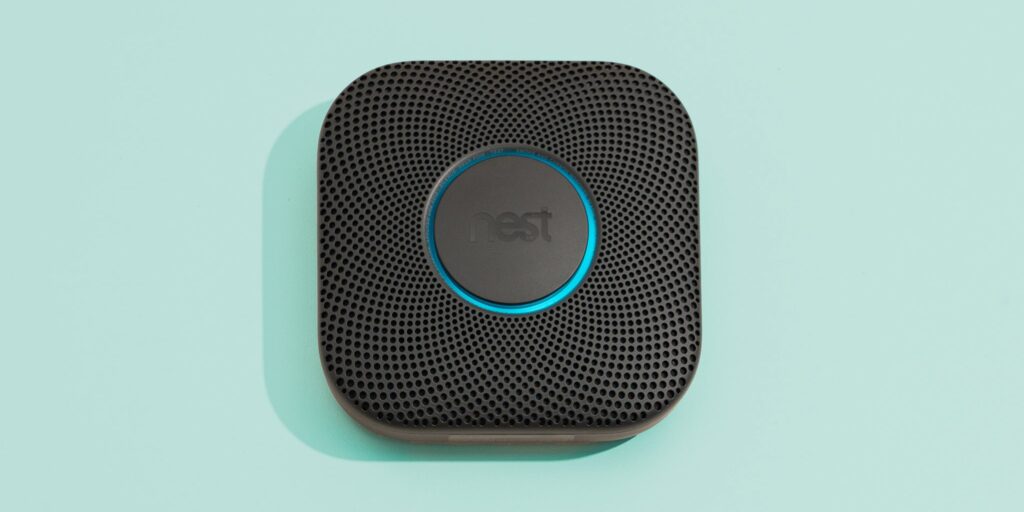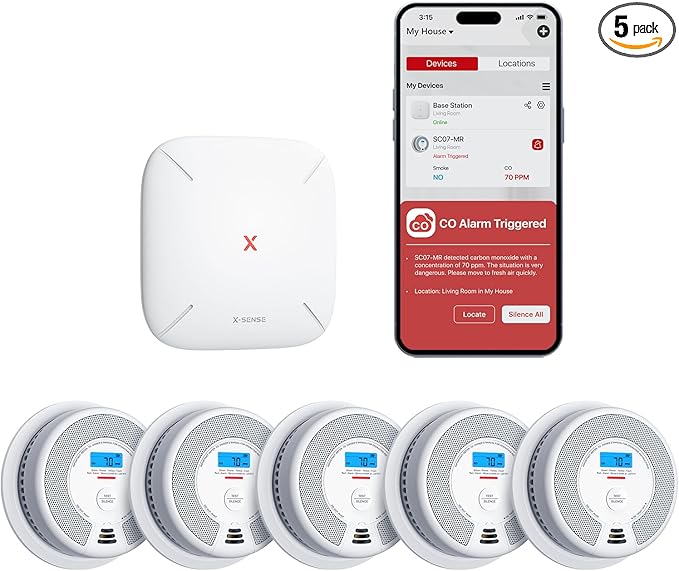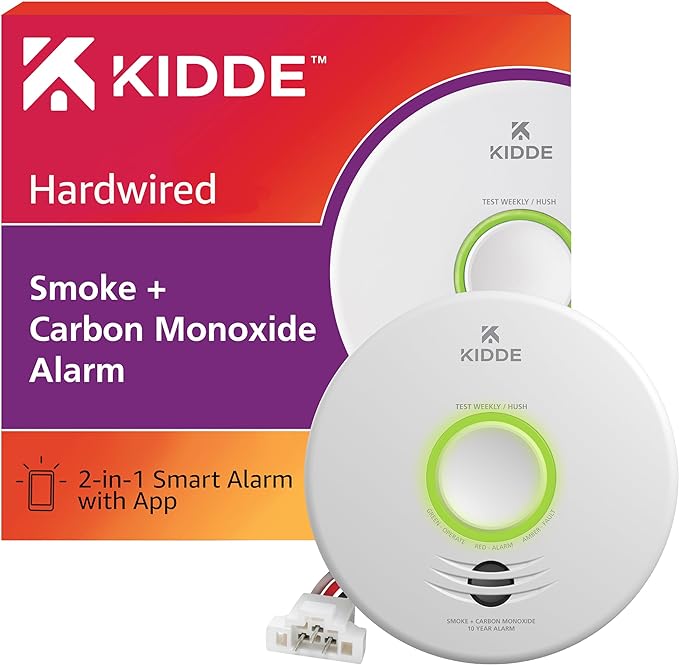Advertiser Disclosure
We independently review everything we recommend. When you buy through our links, we may earn a commission.
The Best Smart Smoke Alarm

When it comes to protecting your home and family, a reliable smoke alarm system isn’t just important—it’s essential. Traditional smoke detectors have served us well for decades, but smart smoke alarms are revolutionizing home safety by providing real-time alerts, remote monitoring, and seamless integration with modern smart home ecosystems.
The smart smoke alarm market has experienced significant growth, with advanced features such as smartphone notifications, voice alerts, and self-testing capabilities becoming increasingly standard. Whether you’re upgrading an existing system or installing protection in a new home, choosing the right smart smoke alarm can make the difference between a minor incident and a devastating fire.
Everything We Recommend
🏆
The Best Overall
Detects both fast and slow-burning fires using a Split-Spectrum Sensor for faster, more reliable alerts.
Sends instant smoke and CO alerts to your phone via smart app connectivity.
Speaks with a human voice to clearly identify the type and location of danger.
Performs automatic self-checks and avoids low-battery chirps for silent reliability.
Installs easily with a battery-powered setup—no wiring required.
💎
Best for Whole-Home Protection
Connects via included base station to 2.4 GHz Wi-Fi and X-Sense app—5.0 GHz not supported.
Sends instant alerts to your phone for alarms, low battery, test results, and system faults.
All connected Link+ Pro alarms sound together when one is triggered, covering your entire home.
Test or silence alarms easily in the app—no ladder needed.
Name each alarm by room and use the Locate feature to pinpoint the exact trigger source.
Optional Protect+ plan enables 3-second emergency response with 24/7 professional monitoring.
10-year smoke and CO protection with a long-life 5-year CR123A battery.
Share control with up to 12 users in the X-Sense app for full household access.
Budget-Friendly Smart Option
Voice alerts clearly announce hazards like “Fire!” or “Warning! Carbon Monoxide!” based on detected danger.
Quick setup by scanning the QR code in the Kidde app—no technical skills required.
Works with Alexa, Google Home, iPhone, and Android for smart home integration.
85 dB alarm with LED lights: green for normal, amber for errors, red for active hazards.
WiFi-enabled to send real-time smoke or CO alerts to your phone and family members.
Photoelectric sensor detects smoldering fires faster by sensing visible particles.
Test-Hush button and app control let you test or silence alarms with ease.
UL Listed with 10-year limited alarm warranty for long-term peace of mind.
What Makes Smart Smoke Alarms Superior to Traditional Detectors
Smart smoke alarms represent a significant advancement over conventional models, offering features that traditional detectors simply cannot match. The most compelling advantage is remote monitoring—you’ll receive instant notifications on your smartphone regardless of your location, ensuring you’re always aware of potential threats to your home.
These intelligent devices also provide detailed information about the type and location of detected threats. Instead of a generic beeping sound, smart alarms can distinguish between smoke, carbon monoxide, and other hazards while communicating the specific danger through voice alerts and mobile notifications.
Additionally, smart smoke alarms eliminate the frustration of nuisance alarms through advanced detection algorithms and the ability to temporarily silence false alarms from your smartphone. Many models also feature automatic self-testing capabilities, ensuring your protection remains active without manual intervention.
Top Smart Smoke Alarm Our Picks
The Google Nest Protect is somewhat pricey, but it’s worth it for the ease of use, convenience in silencing alarms, and peace of mind that comes with knowing that no matter where you are, you’ll be alerted to what is happening with your home. What makes this detector truly stand out is its split-spectrum sensing technology that can actually distinguish between different types of fires before they become dangerous.
Picture this: you’re cooking dinner and accidentally burn something in the oven. Instead of that jarring, ear-splitting beep that sends everyone scrambling, the Nest Protect calmly announces “Heads up, there’s smoke in the kitchen” and gives you time to wave away the smoke or silence it through your phone. This thoughtful approach has saved countless families from the panic and confusion of false alarms.
The real magic happens when you’re not home. Whether you’re at work, traveling, or just out running errands, you’ll get instant notifications on your phone if anything’s detected. One user shared how they received an alert about elevated carbon monoxide levels while at their daughter’s soccer game, allowing them to call a neighbor and address a furnace issue before it became life-threatening.
The included cleaning cloth makes maintenance effortless, and the pathlight feature subtly illuminates your way at night without being intrusive. For families with elderly parents or young children, this gentle nighttime lighting can prevent falls and provide comfort during late-night trips to the bathroom.
This battery-operated unit offers interconnected alarms for whole-home coverage, instant mobile alerts, and easy app control, ensuring you can act fast in an emergency. The SC07-MR51 system is a game-changer for families who want comprehensive protection without the complexity of hardwired installations.
Here’s where this system truly shines: imagine you have a fire starting in your basement while everyone’s asleep upstairs. With traditional detectors, you might not hear the alarm until it’s too late. But with the X-Sense interconnected system, when one detector sounds, they all sound simultaneously throughout your entire home. Plus, your phone immediately receives a notification with the exact location of the threat.
The LCD can indicate real-time carbon monoxide concentration. This feature is particularly valuable for families with gas appliances, fireplaces, or attached garages. Instead of waiting for dangerous levels to trigger an alarm, you can monitor CO levels proactively and address issues before they become emergencies.
The 5-detector pack with base station makes this system incredibly cost-effective for larger homes. One customer mentioned how they protected their 3,500-square-foot home for less than the cost of three premium single units, while getting superior interconnected coverage that works even during power outages.
P4010ACSCO-WF is a smart smoke and CO alarm with Wi-Fi connectivity. Manage home safety with real-time updates via the Kidde app for potential issues and alarm status. This detector proves that smart home safety doesn’t have to break the bank, offering essential connected features from a trusted brand with over 100 years of fire safety expertise.
What makes this detector perfect for budget-conscious families is its hardwired design with a 10-year battery backup. Powered by 120V AC with a sealed, long-life lithium battery backup that lasts for 10 years. This means you get the reliability of hardwired power with the peace of mind of battery backup, all while avoiding the ongoing costs of battery replacements.
The real value becomes apparent when you consider the long-term savings. While other smart detectors might require expensive battery replacements every few years, the Kidde P4010ACSCO-WF’s sealed battery lasts the entire 10-year lifespan of the device. For young families just starting or anyone looking to upgrade multiple detectors throughout their home, this cost efficiency is invaluable.
The Kidde app provides straightforward monitoring without unnecessary complexity. You’ll receive alerts when there’s smoke or CO detected, battery issues, or when it’s time for maintenance. Many users appreciate that it doesn’t try to be everything to everyone—it simply does smoke and carbon monoxide detection exceptionally well while keeping you informed through your smartphone.
Understanding Different Types of Smoke Detection Technology
Modern smart smoke alarms employ various detection technologies, each with distinct advantages for different fire types and environments. Understanding these technologies helps you make an informed decision based on your specific needs and home layout.
Photoelectric Detection
Photoelectric sensors excel at detecting slow-burning, smoldering fires that produce significant smoke before flames appear. Photoelectric sensors are generally better at alerting you about smoldering or slow-burning fires. These sensors work by detecting light scatter when smoke particles interrupt a light beam within the detector chamber.
This technology proves particularly effective for detecting fires involving upholstery, bedding, and other materials that tend to smolder before igniting. Photoelectric detectors also demonstrate reduced sensitivity to cooking smoke and steam, minimizing false alarms in kitchens and near bathrooms.
Ionization Detection
Ionization sensors provide superior detection of fast-burning fires with minimal smoke production. Ionization-type sensors are best at detecting fast-burning fires. These detectors contain a small radioactive source that ionizes air molecules, creating a current flow that smoke particles disrupt.
While highly effective for rapidly spreading fires, ionization detectors may be more prone to false alarms from cooking smoke and require more frequent maintenance. Many experts recommend using both types of detection for comprehensive protection.
Dual-Sensor Technology
The most advanced smart smoke alarms incorporate both photoelectric and ionization sensors, providing optimal protection against various fire types. This dual-sensor approach ensures rapid detection regardless of whether you’re facing a smoldering fire or a fast-spreading blaze.
Smart Smoke Alarm Installation: A Complete Guide
Proper installation is crucial for maximizing your smart smoke alarm’s effectiveness. Install your detector in a central location on each level of your home, especially near sleeping areas, to ensure alarms are heard during the night. The installation process involves both physical mounting and network configuration to ensure optimal performance.
Optimal Placement Guidelines
Smoke rises, so smoke detectors must be mounted high (either on the ceiling or on the wall, no more than a foot below the ceiling). For maximum effectiveness, install detectors on ceilings or high on walls, avoiding corners where air circulation patterns might prevent smoke from reaching the sensor.
NFPA recommends installing smoke alarms high on walls and ceilings on every level of your home, including in each bedroom, the main corridors, and the basement. This comprehensive coverage ensures early detection throughout your living space.
Installation Process
Begin by selecting appropriate mounting locations based on your home’s layout and local building codes. Mark and Drill: Hold the mounting bracket in place and mark the screw holes with a pencil. Drill holes into the marked spots, ensuring proper alignment and secure attachment.
After physical installation, configure the Wi-Fi connection through the manufacturer’s smartphone app. This process typically involves connecting the detector to your home network and registering the device with the monitoring service.
Network Configuration and Testing
Once physically installed, configure your smart smoke alarm’s network settings through the manufacturer’s mobile application. Ensure strong Wi-Fi signal strength at each detector location, as reliable connectivity is essential for remote monitoring and notifications.
Conduct comprehensive testing after installation, including smoke detection tests and communication verification with your smartphone. Regular testing ensures continued functionality and identifies any connectivity issues before they become critical.
Essential Features to Consider When Choosing Smart Smoke Alarms
Modern smart smoke alarms offer numerous features that enhance safety and convenience. Understanding these capabilities helps you select devices that best meet your specific needs and preferences.
Smartphone Integration and Notifications
Advanced smartphone integration represents one of the most valuable features of smart smoke alarms. Quality devices provide detailed notifications including threat type, location, and severity level. Look for apps that offer customizable alert settings and the ability to manage multiple detectors from a single interface.
The best smart smoke alarms also provide maintenance notifications, including battery status, sensor cleaning reminders, and device age tracking. These features ensure your protection remains active and effective throughout the detector’s operational life.
Voice Alerts and Communication
Clear voice alerts significantly improve emergency response compared to traditional beeping alarms. Quality smart smoke alarms announce specific threats and locations, enabling faster and more appropriate responses. Some advanced models also provide voice-guided instructions for emergency procedures.
Integration with Smart Home Systems
Smart smoke alarm compatibility with existing home automation systems enhances overall safety and convenience. Look for devices that integrate with popular platforms like Google Home, Amazon Alexa, Apple HomeKit, and Samsung SmartThings.
This integration enables automated responses such as turning on lights during emergencies, unlocking doors for easier evacuation, or activating ventilation systems to clear smoke. Advanced users can create sophisticated automation routines that respond to different types of threats.
Battery Life and Power Options
Consider both battery-powered and hardwired options based on your home’s electrical infrastructure and maintenance preferences. Many smart smoke alarms feature sealed lithium batteries with ten-year lifespans, eliminating the need for frequent battery changes.
Hardwired models with battery backup provide continuous power while maintaining functionality during electrical outages. These systems often support interconnected operation, where one triggered detector activates all units throughout the home.
Maintenance and Troubleshooting for Smart Smoke Alarms
Proper maintenance ensures your smart smoke alarm system continues providing reliable protection throughout its operational life. Regular maintenance tasks include sensor cleaning, battery monitoring, and connectivity verification.
Regular Maintenance Tasks
Clean your smart smoke alarm sensors monthly using compressed air or a soft brush to remove dust and debris that can interfere with detection accuracy. Avoid using water or chemical cleaners, which can damage sensitive electronic components.
Monitor battery levels through the manufacturer’s smartphone app, replacing batteries as needed or according to manufacturer recommendations. Even hardwired units typically include backup batteries that require periodic replacement.
Troubleshooting Common Issues
False alarms represent the most common issue with smart smoke alarms. Address this problem by ensuring proper placement away from kitchens and bathrooms, cleaning sensors regularly, and verifying that your Wi-Fi network provides stable connectivity.
Connectivity issues can often be resolved by checking Wi-Fi signal strength, restarting your router, or relocating the detector closer to your wireless access point. If problems persist, contact manufacturer’s support for advanced troubleshooting assistance.
When to Replace Your Smart Smoke Alarm
Most smart smoke alarms have operational lifespans of approximately ten years, regardless of battery changes or maintenance. Replace detectors according to manufacturer recommendations or when they begin showing signs of reduced functionality.
Modern smart smoke alarms typically include self-monitoring features that alert you when replacement becomes necessary. Never ignore these warnings, as older detectors may fail to provide adequate protection during emergencies.
Cost Analysis and Value Proposition
Smart smoke alarms represent a significant investment in home safety, with prices ranging from budget-friendly options under $50 to premium systems exceeding $150 per unit. Understanding the value proposition helps justify this investment and select appropriate devices for your budget.
Initial Investment vs. Long-Term Value
While smart smoke alarms cost more than traditional detectors, their advanced features provide substantial long-term value. Remote monitoring capabilities can prevent extensive property damage by enabling faster emergency response when you’re away from home.
Insurance companies increasingly recognize smart home safety devices, with some offering premium discounts for homes equipped with monitored smoke detection systems. Check with your insurance provider about potential savings that can offset initial equipment costs.
Operational Costs and Considerations
Consider ongoing costs, including battery replacements, potential monitoring fees, and eventual device replacement. Many smart smoke alarms include free smartphone apps and cloud services, though some advanced features may require subscription services.
Factor in potential savings from prevented property damage when evaluating overall value. Early fire detection can mean the difference between minor damage and total loss, making smart smoke alarms a worthwhile investment for most homeowners.
Integration with Security Systems and Smart Home Platforms
Modern smart smoke alarms excel in their ability to integrate with broader home security and automation systems. This integration creates comprehensive protection networks that respond intelligently to various threats and emergencies.
Professional Security System Integration
Many smart smoke alarms integrate seamlessly with professional security systems, enabling 24/7 monitoring and automatic emergency response. These systems can contact fire departments directly, potentially reducing response times and property damage.
Professional monitoring services also provide backup communication methods, ensuring emergency notifications reach appropriate authorities even if your smartphone or internet connection fails. This redundancy significantly enhances overall safety and peace of mind.
Smart Home Automation Possibilities
Advanced smart smoke alarms support sophisticated automation routines that extend beyond basic fire detection. These systems can automatically illuminate escape routes, unlock doors, shut down HVAC systems to prevent smoke spread, and activate emergency lighting.
Integration with smart thermostats and air quality monitors creates comprehensive environmental monitoring that can detect problems before they become dangerous. This proactive approach to home safety represents the future of residential fire protection.
Future Trends in Smart Smoke Alarm Technology
The smart smoke alarm industry continues evolving rapidly, with emerging technologies promising even more advanced protection capabilities. Understanding these trends helps you make informed decisions about current purchases and future upgrades.
Artificial Intelligence and Machine Learning
Next-generation smart smoke alarms increasingly incorporate artificial intelligence to reduce false alarms and improve detection accuracy. These systems learn from your home’s normal patterns and can distinguish between cooking smoke and actual fire threats.
Machine learning algorithms also enable predictive maintenance, identifying potential issues before they affect device performance. This technology promises to make smart smoke alarms even more reliable and user-friendly in the coming years.
Advanced Sensor Technology
Emerging sensor technologies promise improved detection capabilities for various types of fires and environmental hazards. Multi-spectral sensors can identify specific types of smoke and gases, providing more detailed threat information for emergency responders.
Enhanced Connectivity and Communication
Future smart smoke alarms will likely incorporate multiple communication methods, including cellular backup and mesh networking capabilities. These improvements will ensure reliable emergency notifications even during network outages or natural disasters.
Conclusion
Smart smoke alarms represent a significant advancement in home fire protection, offering features that traditional detectors simply cannot match. The combination of remote monitoring, intelligent detection algorithms, and smart home integration creates a comprehensive safety system that adapts to modern living requirements.
When selecting smart smoke alarms for your home, prioritize devices that offer reliable detection technology, robust smartphone integration, and compatibility with your existing smart home ecosystem. Consider your specific needs, budget, and home layout when making decisions, and don’t hesitate to invest in quality devices that provide long-term value and peace of mind.
The investment in smart smoke alarm technology pays dividends through enhanced safety, reduced false alarms, and potential insurance savings. As these devices continue evolving with artificial intelligence and improved sensor technology, they will become even more effective at protecting homes and families from fire-related dangers.
Remember that no smoke alarm system, regardless of intelligence level, can replace proper fire safety practices and emergency preparedness. Combine your smart smoke alarm investment with regular safety education, escape plan development, and proper maintenance to ensure maximum protection for your home and loved ones.


